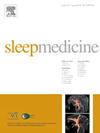White matter changes in patients with narcolepsy type 2: Peak width of skeletonized mean diffusivity study
IF 3.8
2区 医学
Q1 CLINICAL NEUROLOGY
引用次数: 0
Abstract
Objectives
This study aimed to investigate white matter (WM) microstructural alterations in patients with narcolepsy type 2 (NT2) using Peak Width of Skeletonized Mean Diffusivity (PSMD), a novel imaging marker associated with small vessel disease (SVD). The study compared PSMD metrics between patients with NT2 and healthy controls to investigate structural disruptions and their implications for NT2 pathophysiology.
Methods
A total of 42 participants were enrolled, including 20 patients with newly diagnosed NT2 and 22 healthy controls. Diffusion tensor imaging (DTI) was performed using a 3 T MRI scanner. PSMD was calculated using a multi-step process involving preprocessing, skeletonization, application of a custom mask, and histogram analysis with the FSL program. PSMD values were compared between patients with NT2 and healthy controls, and correlation analyses were conducted to examine associations between PSMD and clinical variables.
Results
Patients with NT2 exhibited significantly higher PSMD compared to healthy controls (2.172 × 10−4 mm2/s vs. 2.031 × 10−4 mm2/s, p = 0.011). PSMD also positively correlated with age in both patients with NT2 (r = 0.608, p = 0.004) and healthy controls (r = 0.696, p < 0.001).
Conclusion
Patients with NT2 demonstrate increased PSMD, indicating WM microstructural changes potentially linked to SVD. These findings highlight the utility of PSMD as a sensitive neuroimaging marker for detecting WM alterations in sleep disorders. Further studies are needed to validate these results and investigate the underlying mechanisms of WM changes in NT2.

求助全文
约1分钟内获得全文
求助全文
来源期刊

Sleep medicine
医学-临床神经学
CiteScore
8.40
自引率
6.20%
发文量
1060
审稿时长
49 days
期刊介绍:
Sleep Medicine aims to be a journal no one involved in clinical sleep medicine can do without.
A journal primarily focussing on the human aspects of sleep, integrating the various disciplines that are involved in sleep medicine: neurology, clinical neurophysiology, internal medicine (particularly pulmonology and cardiology), psychology, psychiatry, sleep technology, pediatrics, neurosurgery, otorhinolaryngology, and dentistry.
The journal publishes the following types of articles: Reviews (also intended as a way to bridge the gap between basic sleep research and clinical relevance); Original Research Articles; Full-length articles; Brief communications; Controversies; Case reports; Letters to the Editor; Journal search and commentaries; Book reviews; Meeting announcements; Listing of relevant organisations plus web sites.
 求助内容:
求助内容: 应助结果提醒方式:
应助结果提醒方式:


